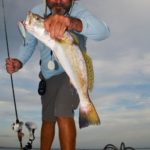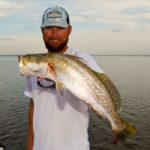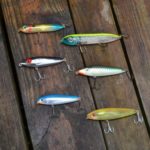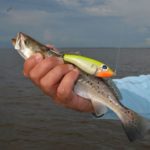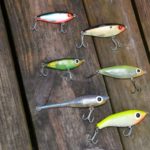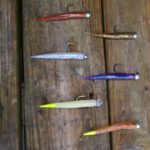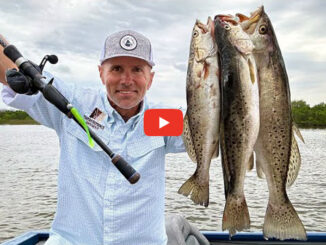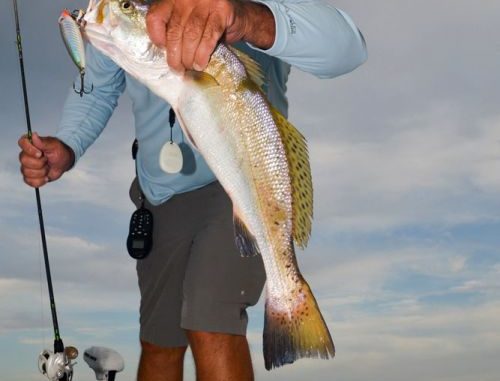
Topwaters, suspending baits and soft plastics can all be effective ways to reel in speckled trout — but the key is knowing when to use them. Two veteran Big Lake guides share their expertise so you’ll know which trick to pick.
Ugh!
I sure was happy when Jeff Poe pointed his boat’s pointy nose north out of Hebert’s Landing on Calcasieu Lake. In the early light, the sky to the south looked like a bruised eggpant — purple and ugly.
Along with the 59-year-old veteran was the young buck, his 29-year-old son Nick, a full-time guide in the family’s fishing and waterfowl hunting business, Big Lake Guide Service.
Our plan was to do a round-robin of speckled trout lure types, starting with topwaters early, shifting to suspending lures later and then closing with soft plastics on jigheads.
They started in 3 ½ feet of water over an oyster reef just south of the small settlement of Deatonville. Nick scored first with a pink-and-chrome MirrOlure She Pup. The vicious chomp made the fish look even bigger than its 3 ½ pounds, and more good fish quickly followed.
“Oysters are the most important habitat in any estuary,” Jeff said. “We can do this all day over oyster reefs in 4 feet of water. We know so many spots like that.”
The father and son obviously were having fun.
“This is like vacation after throwing plastics all day,” cooed the senior Poe, while he unhooked a nice 5-pounder. “But,” added Nick, “the truth is that you can catch trout with all three types of baits at some place almost any day.”
“They are all good,” Jeff nodded in affirmation. “You just need to know when to use them.”
Topwater lures
“Topwaters are a confidence thing,” said Nick firmly. “You can catch them at 2 p.m. on a sunny day in 105 degrees Fahrenheit. Admittedly, it is a little better very early or at dusk.”
“Location has a lot to do with it,” added Jeff. “You don’t want to use them in an area with tidal flow. They are also better in clear water. You lose a lot of fish in dirty water.”
“It needs to be warm, too,” added Nick. “Right,” affirmed Jeff. “It’s not a good wintertime bait.”
Jeff briefly discussed strategy.
“If everyone in the boat is throwing topwaters, I’d have them with three different colors, noises and styles.” By styles, he gave lures as examples: She Pups, Super Spooks and Skitter Walks.
“Try to determine what they want to eat. It’s funny; sometimes everyone will be getting looks (swirls or splashes behind the lures), but they will only eat one bait.
“I don’t know why they do that. If they wanted to eat it, they would.”
“Color makes a difference in topwaters,” said Nick, “but no way I can tell you what to use at any one time. My favorite colors are pink, chrome and chartreuse; chrome belly with a red head and chrome with a blue back.
“If they won’t hit those, I won’t catch fish.”
“I’m not so sure I have favorite colors,” drawled Jeff. “When I start, I start with natural colors like silver with a green back or gold sides with a dark back. But I will always have bright colors like pink or chartreuse ready.”
Nick also noted that he prefers smaller topwater baits over larger ones. “People say, ‘Use big baits for big fish.’ But I think smaller baits catch more fish. Fish don’t discriminate.”
Three companies make all the topwater lures the pair uses: Heddon (Spooks), Rapala (Skitter Walks) and MirrOlure (She Pups, C-eye Pro Dog Jrs. and She Pups.)
One thing they both agreed on was the treble hooks on topwater lures demand some safety precautions. Always use pliers, they stressed. Also, when one set of hooks in a lure becomes tangled in the landing net, leave them in place so they can’t get you while you unhook the others from the fish.
Pros for topwater lures:
1) They are good locator lures because you can cover a lot of water with them. You can get a blow-up on one, then go to a jig and mop up.
2) Fish caught on them are, on average, larger than with other lures.
3) Strikes are visual. You get to see the action. It’s an exciting way of fishing.
4) Sometimes trout will eat them when they won’t bite anything else. If you are not having any action on the bottom, it often pays to try a topwater “just to see.”
5) It’s easier to make long casts. They will cast further than anything else in the box.
6) They are great in windy conditions because they are aerodynamic. Also, trout will smash them in waves as large as 3 feet.
Cons for topwater lures:
1) Treble hooks are dangerous.
2) Topwaters can only work one segment of the water column.
3) They produce a lot of missed hits.
4) They are an expensive investment, although they last longer than soft plastics. Sometimes, it seems, the more beat-up they are, the better they work.
5) Most of the time, a fisherman will come home with less on ice because of the time required in handling the fish.
6) They are a poor choice for inexperienced fisherman because they require significant skill to be worked properly.
Suspending lures
Suspending lures, also called twitch baits, used by the Poes fall into two groups — hard and soft. All their favorites are sold by MirrOlure. “There are others, but these are what we use,” said Jeff.
His favorite hard-bodied suspender is a MirrOlure MirrOdine XL with a black back, silver sides and orange belly. Nick likes the same color, but in the regular size rather than XL.
Jeff likes the big version because of its weight. “It goes way further when you cast.”
Early in the year, he admits to using the smaller one like Nick, but by June pogies, a prime trout food, are bigger and trout are used to feeding on them.
The MirrOdine is it for them.
“It has a really erratic motion,” explained Nick. “It has a lot of flash and it looks like easy pickings for a trout,” added Jeff.
Prime time for this bait is from November through May. “Fish will take suspenders,” said Jeff, “when the water is chilly and they are reluctant to come to the surface to feed.
“It is usually worked with twitches and pauses, but you have to vary the retrieve to find what they want. Sometimes you can’t work it hard enough. Other times you have to tick the lure off the oysters.”
Their favorite soft-bodied suspending lures are Soft-Dines, Paul Brown’s Original Fat Boy and Paul Brown’s Devil. Soft-Dines are modeled on MirrOdines, and also are sold in two sizes.
Jeff observed that Soft-Dines seem to work better in dirtier water than do MirrOdines. Nick explains his view of their uses. “If I’m throwing a Soft-Dine, I’m looking for a bunch of fish. If I’m throwing a Fat Boy or a Devil, I am looking for one bigger fish.”
Jeff nodded in agreement, adding that Fat Boys and Devils are winter baits.
The two captains agreed that they would rather fish for speckled trout with suspending baits than topwaters. “I fish for the thump,” rumbled Jeff.
“Yeah, the thump,” echoed Nick.
“There is a little more to fishing these than to topwaters,” said Jeff. “The bite is subtle and I feel like you almost have to talk the fish into biting.”
“These really are harder baits for the average person to fish,” agreed Nick.
Favorite colors for soft suspending baits for Nick are pearl with a chartreuse back, or chartreuse back, gold sides and a white belly for Fat Boys and a black back with chartreuse or gold sides for Soft-Dines.
Jeff’s favorites are black back, gold sides with an orange belly, or pink and pearl for Fat Boys and a chartreuse back with translucent sides for Soft-Dines.
Pros for suspending lures:
1) Suspending baits work well in colder water when topwater lures aren’t effective.
2) They can be fished from near the bottom all the way to near the surface. Sometimes they want it popping out of the water, but they still might not take topwaters.
3) Suspending fish on average are larger than those caught on soft plastics.
4) Like topwater lures, they are easy to cast, even in the wind.
5) Because they are worked so slowly, they can be kept in the strike zone longer.
6) You get satisfaction from learning to master the lure — subtle differences matter.
Cons for suspending lures:
1) They are a little fragile. Redfish mangle them and they cost $8 to $9 each. If you catch15 trout on one, that’s a lot.
2) They require patience to fish. A lot of people fish too fast to use them.
3) They are more difficult to master than are other lures. They require the angler pay attention to his lure and concentrate. Many people can’t catch fish on them.
4) They are a poor choice for fishing in warmer water.
5) Treble hooks are a hazard. Although the Devil has only one set of treble hooks, the others have two.
Soft plastics
This lure has two components: a hook-bearing jighead and a soft plastic grub. The Poes use 1/16-, 1/8-, ¼-, 3/8- and rarely, ½-ounce jigheads. Their rule of thumb is to fish the lightest one that will get the lure to where the fish are.
“A bait with a lighter head is presented so much better to a fish than one with a heavier head,” explained Nick.
“You can work a lighter bait a lot slower, too,” injected Jeff. “It allows you to work it right off the bottom, right where the fish are. My bait is never not-moving.”
“But if the current is sweeping your bait through the fishing zone too quickly, then go to a heavier head,” added Nick.
The main place that they will use a ½-ounce jighead is at offshore rigs, and then primarily to get the lure quickly through the bluefish, ladyfish and jacks that are higher in the water column. The smallest they typically use offshore is 3/8-ounce.
“An important note here,” said Nick, “is to weigh your jigheads. With a lot of the companies, the heads don’t weigh what’s printed on the pack.”
“Not even close,” spat Jeff.
“That can make a huge difference,” Nick went on. “The weight of the head has more to do with success than the choice of tail style.”
“Most people use too big a jighead,” said Jeff. “In the morning with customers, we cut their lures off their rods to tie on ours. Their jigheads are too heavy.
“They think it helps cast further, when what they really need is lighter lines and full spools on their reels.”
Hooks on the Poes’ jigheads are 2/0, and the heads are round in shape and unpainted.
Plastics used on jigheads come in three basic shapes: paddle tail, beetle and what they call “eel type.”
“Ninety percent of the time, I use MirrOlure Lil Johns, an eel-type bait,” said Jeff flatly. “But you can probably catch them on any of the other tails.”
When he isn’t using Lil Johns, he uses beetles, mostly when it gets hot in July and August, and shrimp numbers are high. “I think that it’s the best shrimp imitator. Every twitch, it goes in a different direction.”
“I seldom use paddle tail baits,” piped in Nick. “I don’t like the way they fall. They are hard to use in deep water—10 feet or better, with current. I don’t want to have to go to a heavier jighead.
“I do think that paddletails catch more fish in dirty water, though.”
Color choice is simple. If the water they are fishing is pretty, they use something translucent, like watermelon red or golden bream. If the water is dirty, they throw solid colors like purple, black or glow.
Neither use chartreuse-tailed baits, with the exceptions of chicken-on-a-chain and glow. Neither do they use added scents, although they admit that Lil Johns have some scent built in.
As for retrieves, Jeff said a steady retrieve can be effective at times, but that he doesn’t enjoy using it. “I give the bait twitches, sometimes gentle, sometimes sharp, but I am not trying to move it a lot. What I’m trying to do is keep the lure in one spot as long as I can.”
Pros for soft plastics:
1) They are inexpensive and durable enough to catch 20 or 25 fish on one lure.
2) They can be fished at any depth.
3) It’s easy to change colors without retying the line.
4) It’s the easiest artificial bait to learn how to fish.
5) It’s the best bait for catching large numbers of fish.
6) It’s versatile enough to catch almost any species — even bass in Toledo Bend will bite them.
7) It is a 12-month-a-year bait, not seasonal. Use lighter heads — down to 1/16-ounce, when it is cold. In Calcasieu Lake, the Poes catch big trout by fishing slowly in 2-foot depths on foggy, warm, cloudy winter days.
8) With only one hook, it is safer than other baits.
9) It can be fished effectively in current by using heavier jigheads.
Cons for soft plastics:
“There ain’t none,” twanged Nick. “It is the end-all, be-all for speckled trout. There is nothing even close.”
“If you had to fish with only one bait, this would be the one,” boomed Jeff.
“Watermelon red Lil John on an 1/8-ounce head would be it,” they chimed in unison.
